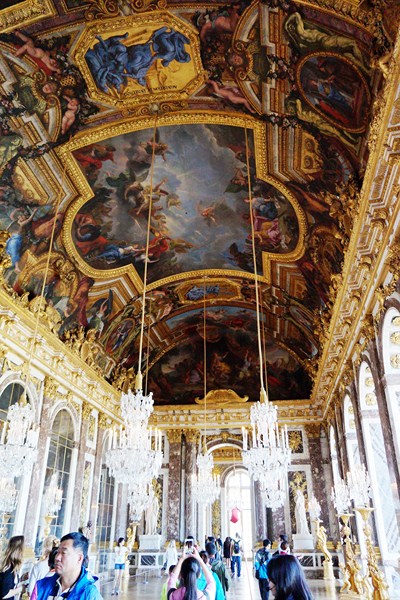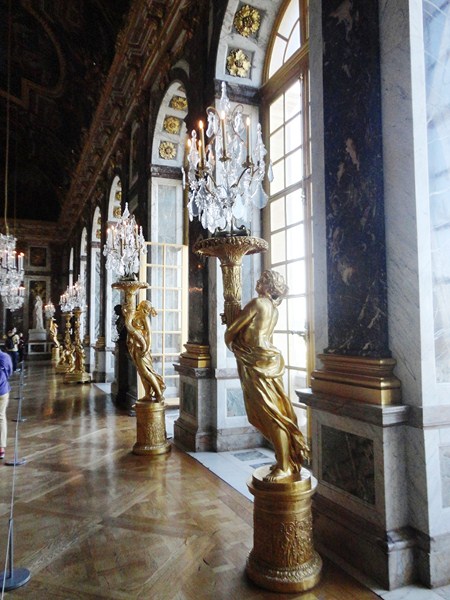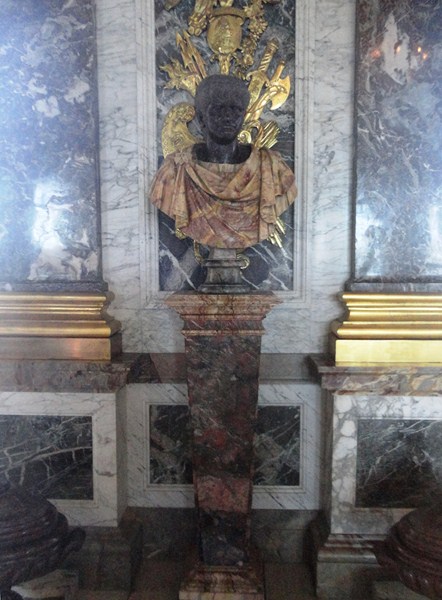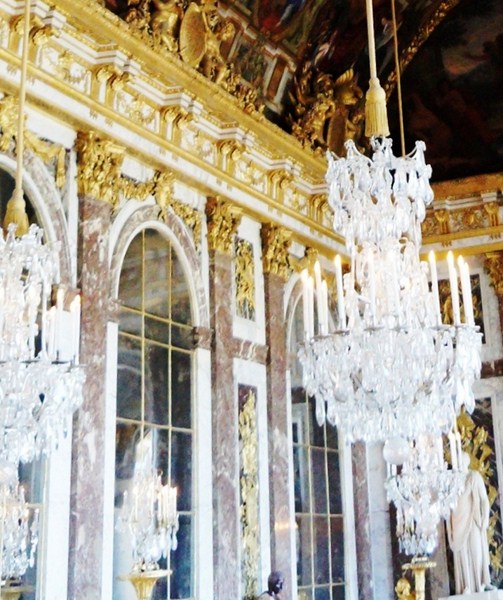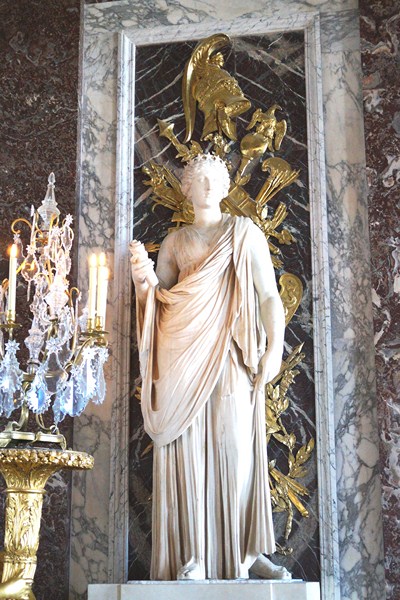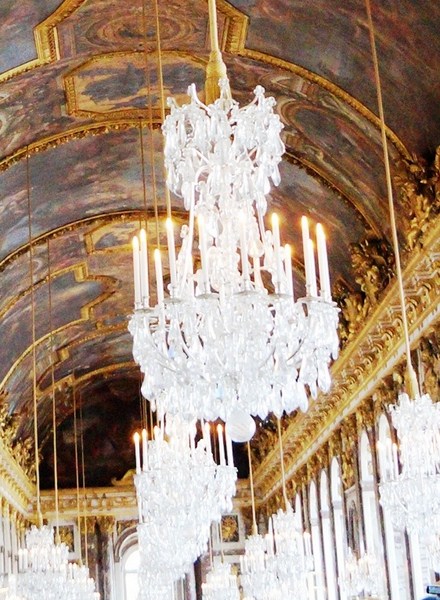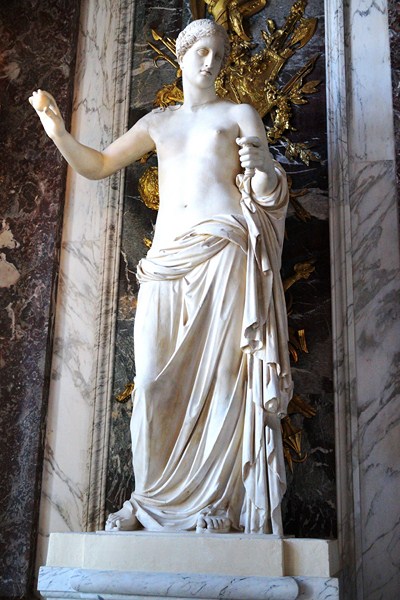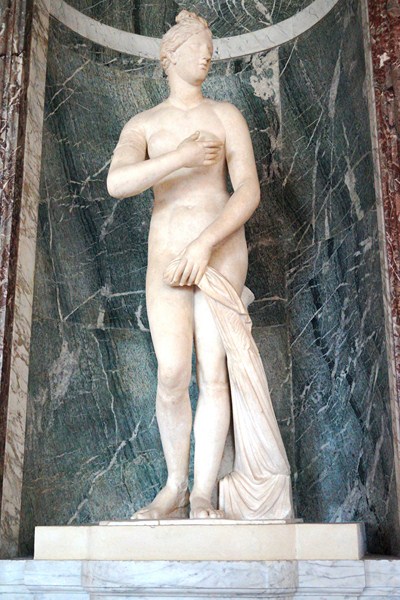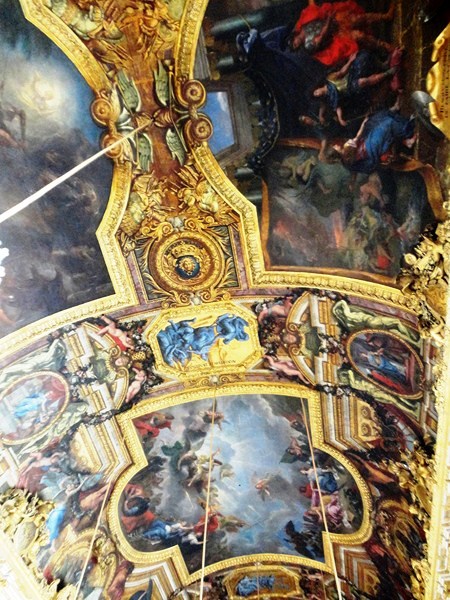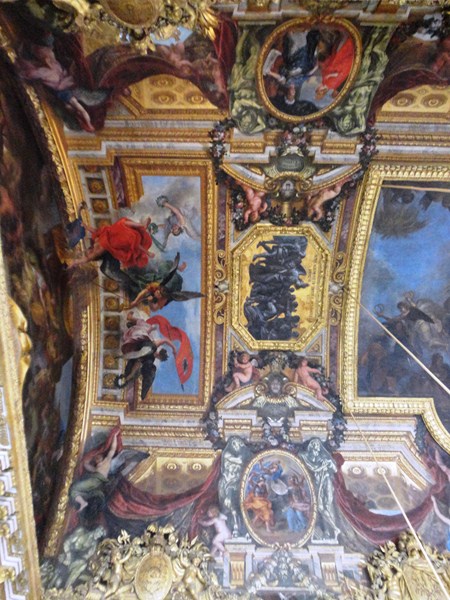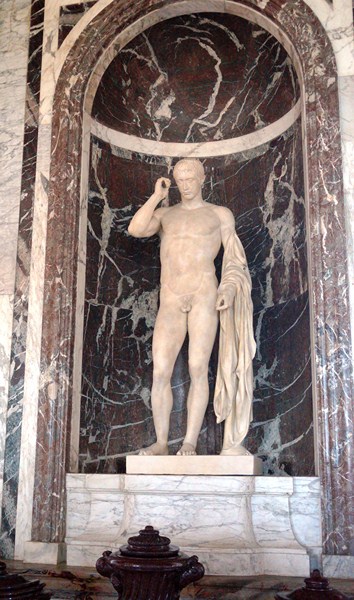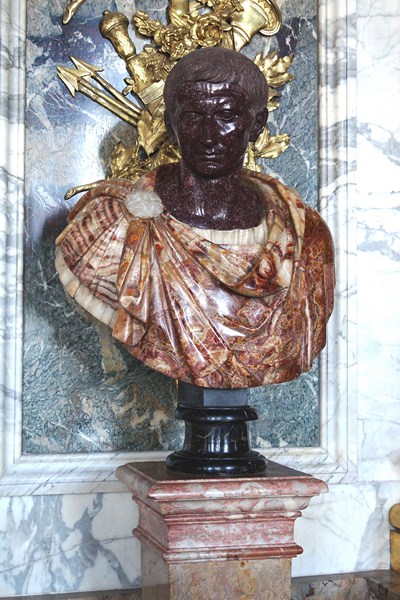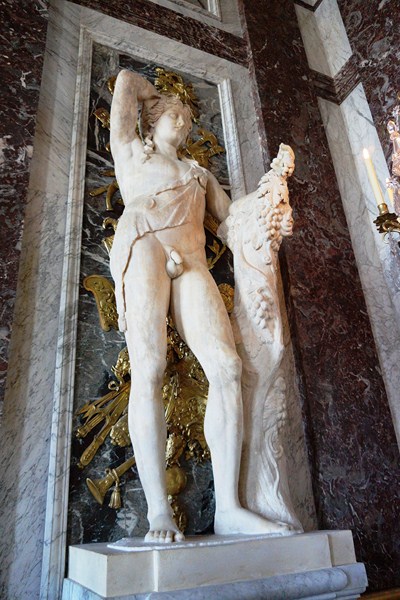The Hall of Mirrors (Galerie des Glaces), the most famous and emblematic room in the royal Palace of Versailles, is located on the ground floor of the palace’s central body, facing west towards the Palace Gardens. Located besides the Palace Chapel, it is flanked, at the far ends, by the Salon of War (Salon de la Guerre) in the north and the Salon of Peace (Salon de la Paix) in the south, respectively. The Hall of Mirror connects to the two salons, which were assigned to and incorporated into the king’s apartments (grand appartement du roi) in the north and the queen’s apartments (grand appartement de la reine) in the south.
Check out “Versailles Palace” and “Versailles Palace – Grand Gallery”
It was built, during the palace’s third building stage (between 1678 and 1684), to replace a large rooftop terrace designed by the architect Louis Le Vau, which originally stood between the King’s Apartments to the north and the Queen’s to the south and opened onto the garden. The terrace was awkward (it was considered to be a rather misplaced architectural element) and, above all, especially exposed to bad weather (which reduced its utility) and it was not long before the decision was made to quickly condemn and demolish it.
Jules Hardouin-Mansart, Le Vau’s successor, produced a more suitable design that replaced the terrace with the grand, Baroque-style Hall of Mirrors. He appropriated three rooms each from the King and the Queen’s apartment as well as the terrace that separated the two apartments.
The hall pays tribute to the political, economic and artistic success of France. The 30 painted compositions on the vaulted ceiling by artist Charles Le Brun (who created the interior decorative apparatus), illustrate the political successes by depicting the glorious history of Louis XIV during the first 18 years of his reign, starting with the Treaty of the Pyrenees (1659) to the Treaty of Nijmegen (1678–1679).
The allegories from Antiquity illustrate the military and diplomatic victories and reforms, with a view to reorganizing the kingdom. The number and size of the 357 mirrors (which, in the 17th century, were an expensive luxury product that could only be produced with great effort) bedecking the 17 arches opposite the windows, demonstrated that the new French manufacture, by the Manufacture royale de glaces de miroirs (later Compagnie de Saint-Gobain), a glass factory founded by Jean-Baptiste Colbert, could rival the Venetian monopoly on mirror manufacturing in Europe, thus revealing economic prosperity.
According to legend, the government of the Venetian Republic, in order to keep its monopoly, sent agents to France to poison the workers whom Colbert had brought to France.
The Rouge de Rance marble pilasters, topped with gilded bronze capitals based on a new design (which was referred to as “the French style”) and created by Le Brun upon the request of Colbert, showed artistic success.
The design, incorporating the national emblems, featured a fleur-de-lis topped by a royal sun between two Gallic roosters (the Latin word for rooster was gallus) or cockerels. Adorning the green marble Pier glasses are gilded bronze trophies manufactured by goldsmith Pierre Ladoyreau. In its heyday, over 3,000 candles were used to light the Hall of Mirrors.
Work on the Hall of Mirrors started in 1678 and ended in 1684, at which time it was pressed into use for court and state functions. Upon its completion, it served as a kind of covered promenade for Louis XIV’s visit to the chapel.
At least once a day, he entered the gallery and, from 1701, the king’s bedroom lay behind the middle wall of the gallery. Courtiers and visitors crossed the Hall of Mirrors daily and assembled there to watch the King walk from his apartments to the chapel with members of the royal family. Sometimes, they took the occasion to present him with requests.
In the successive reigns of Louis XV and Louis XVI, family and court functions, embassies, and births were held in this room. It also served as a place for waiting and meeting. On rare occasions, the central location and size of Hall of Mirrors was used, for an extra dash of lavishness and for entertainment, for ceremonies such as full-dress and masked balls and royal weddings. They include:
- The wedding of Louis Ferdinand and Maria Theresa of Spain(1645)
- The wedding of the Duke of Burgundy with Marie Adélaïde of Savoy (December 11 and 14, 1697)
- The wedding of Louis XVI and Marie Antoinette (May 16, 1770)
- The celebrated Yew Tree Ball (February 25, 1745) – during this costume ball, Louis XV (who was dressed as a yewtree) met Jeanne-Antoinette Poisson d’Étiolles (who was costumed as Diana, goddess of the hunt). Jeanne-Antoinette, better known to history as the Marquise de Pompadour, became Louis XV’s mistress.
Rarely has the show of power reached such a level of ostentation than during this time. Foreign audiences, under the scrutiny of the French Court (seated to either side on tiered seating), were granted here and dignitaries and ambassadors had to cross the full length of this gallery before they could reach the king.
During diplomatic receptions, the silver throne (usually located in the Salon of Apollo) was placed on a platform at the end of the hall near the Salon of Peace, whose arch was closed off. The audiences that transpired in this room include the following:
- The Doge of Genoa (1685)
- The Siamese Embassy (1685 to 1686) – the most opulent audience of them all. At this time, the Hall of Mirrors and the grand appartements were still decorated with its original silver furniture.
- Mehemet Reza Bey, ambassador of the Shah of Persia (February 1715)
- The embassy of King Mahmud I of Turkey (1742)
One of the largest rooms in the palace, the Hall of Mirrors is 73 m. (240 ft.) long, 10.50 m. (34.4 ft.) deep with a height of 12.30 m. (40.4 ft.) reaching to the Attic floor of the Corps de Logis.
The principal feature of this Mirror Hall is the 17 mirror-clad arches that reflect the 17 equally large, arcaded windows that overlook the gardens. The mirrors, composed of 357 individual mirror surfaces, aesthetically mirror the image of the garden and the exterior of the castle into the interior of the building. The square windows on the upper floor, which can be seen from the outside, only serve aesthetic purposes as there are no rooms inside.
According to a contemporary anecdote: the mirror surface furnishings of such large areas as the 17 arches has been the idea of architect Jules Hardouin-Mansart, who wanted to prevent Le Brun from having even more opportunities to impress Louis with his work.
The original solid silver furniture by LeBrun, famous at the time, was soon lost, particularly the large, gilded silver guéridons (tables) lining the hall which were, in 1689, melted down and coined by order of Louis XIV to finance the War of the League of Augsburg.
Those on display today were made in 1770 for the marriage of Louis XVI and Marie Antoinette, based on the moldings of earlier silver versions made that had been melted down. The 24 crystal chandeliers were hung only for special occasions. The Hall of Mirrors’ furniture was manufactured during the 19th century as most of the original furnishings were lost during the French Revolution
Besides the mirrors, the Hall’s grandeur is best perceived through the majesty of its vault whose nine large and numerous smaller ceiling paintings, by Charles Le Brun (the most prestigious scenes were painted on strengthened canvas and glued to the vault by Le Brun himself), are dedicated to the idolization of the Sun King, praising the political policies and military successes of the first 20 years of his reign.
The claim to absolute power is highlighted by the painting The King Governs Himself (Le roi gouverne par lui-même) which alludes to the establishment of the personal reign of Louis XIV in 1661.
It shows Louis XIV, facing the powers of Europe and turning away from his pleasures, to accept a crown of immortality from Glory, with the encouragement of Mars. Further topics include the Peace of Nijmegen and the Conquest of the Franche-Comté.
On display here are marble and porphyry busts of eight Roman emperors (Julius Caesar, Caligula, Claudius, etc.) plus statues of Greek and Roman deities and Muses, such as Bacchus, Venus of Troas, Modesty, Hermes, Urania, Nemesis and Diana of Versailles.
The latter is just a copy. The original, moved to the Louvre in 1798, was replaced by a Diana sculpted by René Frémin for the gardens of the Château de Marly. Upon the restoration of the Hall of Mirrors during 2004 to 2007 it was, in turn, replaced by a copy of the original Diana.
On a number of occasions, the Hall of Mirrors has been the scene of events of great historic significance. They include:
- On January 18, 1871, in a deeply humiliating ceremony at the conclusion of the Franco-Prussian War, Prussian king William I, led by Otto von Bismarck, was declared German emperor (thus establishing the German Empire) in the Hall of Mirrors by the assembled German princes and lords. The event greatly contributed to the further accretion of the Franco-German enmity.
- O June 28, 1919, the Treaty of Versailles, officially ending the World War I, was signed here by French Prime Minister Clemenceau to dismantle the German Empire.
Since then, the Hall of Mirrors remains reserved for official ceremonies and presidents of the French Republic have continued to receive official guests here. Among them were:
- The reception of US-President John Fitzgerald Kennedy and his wife by Charles De Gaulle
- The reception of the Shah of Iran Mohammad Reza Pahlavi by Valéry Giscard d’Estaing in 1974
- The invitation of representatives of the Group of Seven summit by President François Mitterrand from June 4 to 6, 1982.
Hall of Mirrors: Chateau De Versailles, Place d’Armes, 78000 Versailles, France. Tel: +33 1 30 83 78 00. Website: www.chateauversailles.fr. Open daily (except on Mondays and May 1), from 9:00 AM to 6:30 PM. Last admission is 6 PM while the ticket office closes at 5.45 PM. The estate of Trianon and the Coach Gallery only open in the afternoon while the Park (7 AM to 8:30 PM) and Gardens (8 AM to 8.30 PM, last admission: 7 PM) are open every day. Access to the Gardens is free except on days of fountains shows. You can access the estate of Trianon through the Gardens or through the city. The Petit Trianon is only possible via the Grand Trianon.
Admission: 27 € for Passport with Timed Entry (days with Musical Fountains Shows or Musical Gardens), 20 € for Passport with Timed Entry (without musical fountains show or musical gardens), 12 € for Estate of Trianon ticket(without Musical Fountains Show or Musical Gardens), 10 € for Passport with Timed Entry (free admission, days with Musical Fountains Show or Musical Gardens), 9,50 € for Musical Fountains Show ticket, 8,50 € for Musical Gardens ticket, 28 € for the Fountains Night Show.
How to Get There: The cheapest option for reaching Versailles is by train. There are three train stations in Versailles. RER line C arrives at Versailles Château – Rive Gauche train station, the closest one of the Palace (just 10 minutes’ walk to the Palace). SNCF trains from Gare Montparnasse arrive at Versailles Chantiers train station, which is 18 minutes on foot to the Palace. SNCF trains from Gare Saint Lazare arrive at Versailles Rive Droite train station, 17 minutes on foot to the Palace. RER C and SNCF train times are available on www.transilien.com

